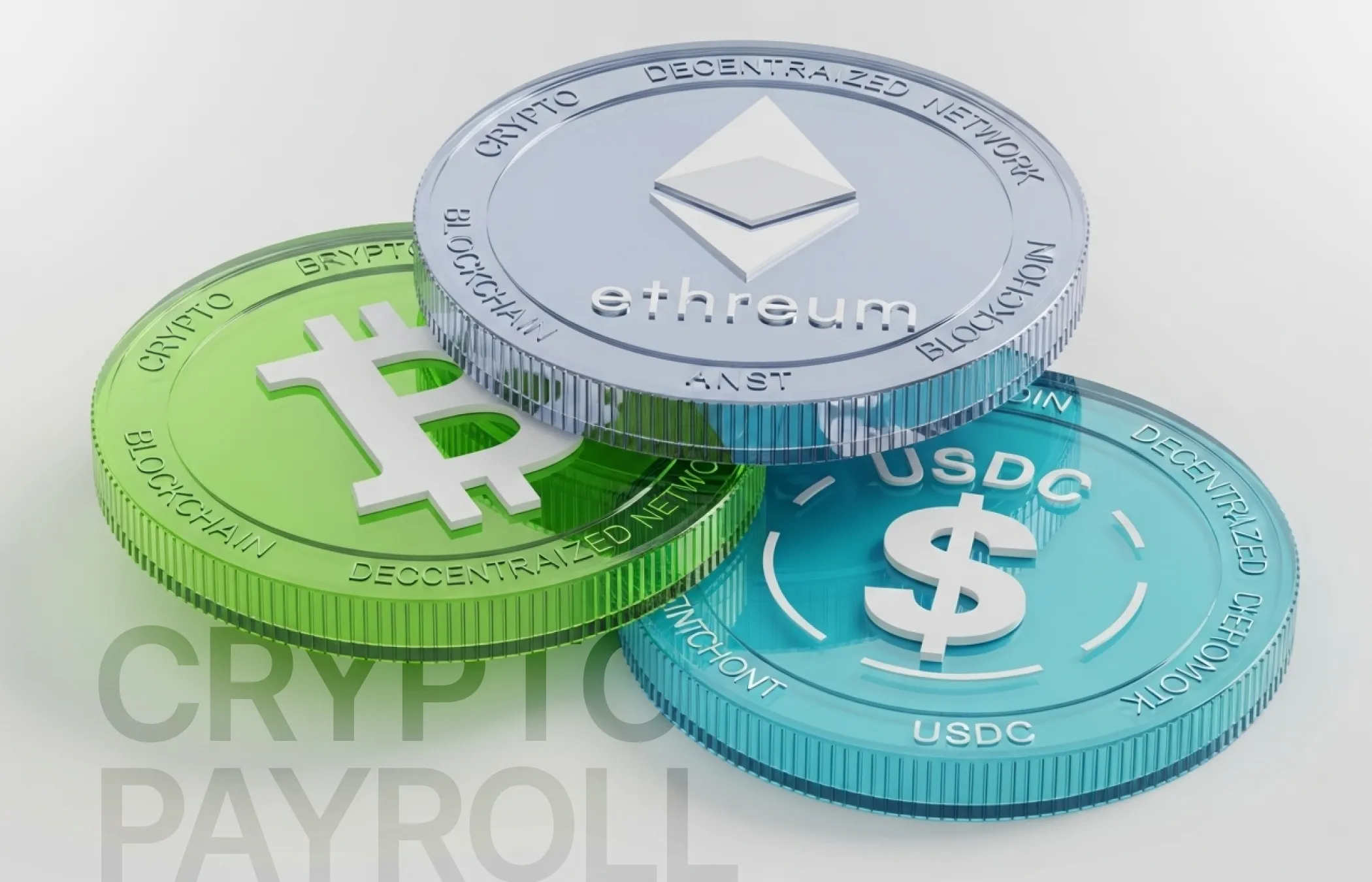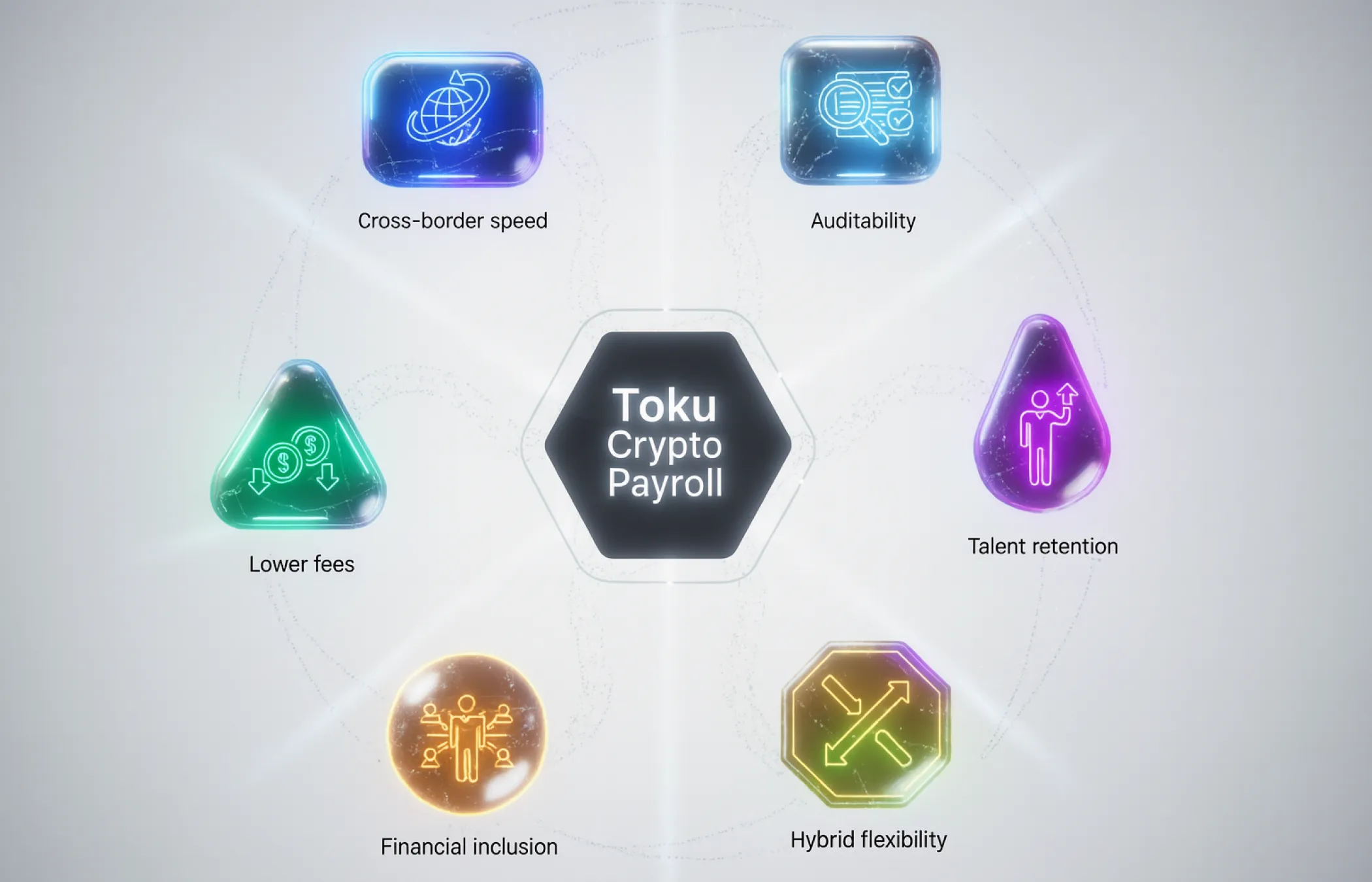
Crypto Payroll Guide (2025): How Global Teams Get Paid in Crypto Safely
Learn how crypto payroll works in 2025. A full guide to paying global teams in USDC, BTC & ETH - legally, efficiently, and without compliance headaches.

.avif)
Paying employees and contractors in crypto isn’t a fringe experiment anymore - it’s a modern solution to an old problem: how do you pay a distributed team efficiently, affordably, and compliantly?
That’s where crypto payroll comes in.
Put simply, crypto payroll refers to the process of compensating employees or contractors using digital assets like USDC, ETH, BTC, or other cryptocurrencies - either fully or as part of a hybrid (fiat + crypto) salary.
And it’s gaining traction fast.
Enterprise adoption of digital assets is accelerating as can be seen by the indicators below:
- Nearly 1 in 4 North American CFOs say their finance functions will be using digital currency within two years, signaling growing readiness for operational use, including payroll and payouts (Deloitte, 2025: CFO signals and attitudes).
- In compensation specifically, a 2024 industry survey found that 9.6% of crypto‑sector employees were paid in crypto by the end of 2024, and over 90% of those salaries were in stablecoins (USDC and USDT) (Pantera Compensation Survey, via Blockworks, 2025).
- Separately, the Federal Reserve’s 2024 Business Payments Study highlights that businesses increasingly prioritize instant payroll and individualized disbursements, which stablecoins can enable, underscoring the direction of travel without asserting a global 25% penetration figure (Federal Reserve, 2024).
These signals point to rising, compliance‑minded adoption of stablecoin‑powered payroll and payouts.
Why? Because traditional payroll systems were built for single-country, banked employees. Crypto payroll, especially when powered by stablecoins, is borderless by default. It unlocks faster payments, lower fees, better transparency, and easier access for talent in underbanked regions.
But there’s a catch: crypto payroll isn’t plug-and-play.
If you’re serious about it, you need to get the compliance, tax, and operational setup right - or risk penalties, reporting gaps, or unhappy employees.
That’s why we made this guide.
We’ll walk you through everything you need to know - from how crypto payroll works, to compliance obligations by region, to how to actually set it up using tools like Toku - the SOC 2–certified payroll platform trusted by companies like Mina Foundation, Astar Network, and dYdX.
Let’s break it down.
What Is Crypto Payroll - and How Does It Work?
Crypto payroll is the process of paying employees, contractors, or contributors in cryptocurrency - usually stablecoins like USDC or USDT, but sometimes tokens like ETH or BTC. Payments can be 100% crypto or a hybrid split (e.g. 70% fiat, 30% crypto).
Unlike traditional payroll, which relies on bank rails and slow international wires, crypto payroll runs on blockchain infrastructure. It’s fast, transparent, and - when done right - fully compliant.
How Crypto Payroll Works
Here’s what a typical crypto payroll process looks like:
Step 1: The employer funds the payroll wallet
This can be done in fiat (e.g., USD) or stablecoins. If funded in fiat, a conversion step is required - usually handled by the payroll platform.
Step 2: The payroll platform automates conversion and distribution
Platforms like Toku handle KYC, AML, FX rates, and regulatory logic. They automate salary splits (e.g., 50% USDC, 50% fiat), apply compliance rules, and generate tax-ready records.
Step 3: Employees receive funds in their chosen wallet or currency
They can be paid in USDC, ETH, BTC, or local fiat. Recipients get full transparency and faster access - often in seconds, not days.
Step 4: Reporting and compliance handled automatically
The employer gets tax forms, audit logs, and compliance documentation. Employees get clear transaction records and value history for tax filing.

Why It Matters:
Crypto payroll simplifies payments for global teams - but it only works when compliance and tax reporting are built in. That’s why forward-thinking companies are adopting crypto-native payroll platforms like Toku that offer:
- Built-in AML/KYC verification
- SOC 2–certified infrastructure
- Jurisdiction-specific tax form generation
- Flexible crypto/fiat payment options
Next up: why companies are choosing crypto payroll over traditional systems - and what benefits they’re seeing.
Why Companies Are Adopting Crypto Payroll
Crypto payroll isn’t just a novelty - it’s solving real problems for global teams.
From remote-first startups to DAOs, companies are turning to stablecoin payroll to fix what traditional systems have failed to solve: slow cross-border wires, excessive fees, bank-dependent bottlenecks, and complex compliance overhead. And in 2025, it’s no longer a fringe experiment - it’s becoming the norm.
Here’s why:
1. Instant Cross-Border Payments
Sending fiat across borders takes 3–5 days on average - and that’s if nothing goes wrong. Crypto settles in seconds, 24/7/365. No banks, no SWIFT, no waiting for the “next business day.”
2. Lower Transaction Costs
A $2,000 wire to a contractor in the Philippines? That’s easily $50+ in fees. With USDC, the cost can be under $1. Platforms like Toku negotiate volume-based rates even lower - often around 0.3%.
3. Financial Inclusion for the Unbanked
Roughly 1.4 billion adults globally don’t have access to a traditional bank account (World Bank, 2022). Crypto allows teams to pay anyone with a mobile wallet - no bank required. It’s financial inclusion, powered by blockchain.
4. On-Chain Transparency and Auditability
Every payment is verifiable, timestamped, and visible on the blockchain. This eliminates black-box payroll systems and builds trust - especially for decentralized teams and DAOs.
5. Talent Attraction and Retention
Web3 and remote-first companies are competing for top-tier developers, contributors, and creatives. Offering crypto payroll - especially in stablecoins - is a magnet for talent who want autonomy, speed, and global flexibility.
Real-world examples:
Companies like Paxos now let employees opt into stablecoin salaries via Toku, within existing payroll systems (ADP and Workday), reducing friction and aligning with employee preferences (Paxos, 2025).
Teams using Toku report simpler, compliant split‑pay experiences where fiat and stablecoins arrive simultaneously, improving perceived pay flexibility and reducing operational friction (dYdX International case).
6. Multi-Currency and Hybrid Pay Flexibility
Toku lets employees split pay across multiple assets: for example, 70% in USDC, 30% in local fiat. This kind of flexibility is impossible with most traditional payroll systems - and it’s exactly what global teams need.

Top 6 Benefits of Crypto Payroll
Toku clients aren’t switching to crypto payroll because it’s trendy - they’re doing it because it’s better.
The Role of Stablecoins in Payroll
When people hear “crypto payroll,” they often think of Bitcoin or Ethereum - but those aren’t what most teams are actually using.
The truth is: Stablecoins like USDC and USDT power the majority of real-world crypto payroll today.Why? Because they combine the speed of crypto with the price predictability of fiat. And when you’re paying salaries, stability isn’t optional.
Why Not BTC or ETH?
Bitcoin is powerful for long-term value storage. Ethereum is the backbone of smart contract innovation. But as salary currencies, both are volatile - with prices capable of swinging 10–20% in a single week. That’s not something you want to see on payday.
Imagine getting paid $3,000 on Friday… and waking up Monday to find it’s worth $2,400.
That’s why the vast majority of companies choose stablecoins, especially USDC.
Why Stablecoins Like USDC Dominate Payroll
Stablecoins are pegged 1:1 to fiat currencies, typically the U.S. dollar. They’re backed by real-world assets, verified through audits, and designed for price stability - making them ideal for both employees and finance teams.
Key advantages:
- Price Stability - no “crypto crash” surprises
- On-Chain Speed - instant settlement like any crypto asset
- Fiat On/Off-Ramps - easy to convert to local currency
- Regulatory Clarity - especially for fully reserved assets like USDC
- Multi-chain Compatibility - send via Ethereum, Solana, Polygon, and more
Why Toku Prioritizes USDC
Toku integrates with multiple stablecoins, but USDC is the most commonly used across our client base. It’s:
- Fully backed 1:1 by cash and short-dated U.S. Treasuries
- Audited monthly by top-tier firms
- Widely supported across major blockchains and wallets
- Regarded as the most trusted dollar-pegged asset in Web3
Stablecoin Comparison Table
Toku Tip: We support hybrid payouts too - so you can offer employees a split like 80% USDC, 20% ETH, or whatever suits your comp strategy. Flexibility meets compliance.
In the next section, we’ll tackle the elephant in the room: compliance.How do you handle taxes, legal regulations, and international crypto payroll laws without getting burned?
Compliance, Legal, and Tax Considerations
Crypto payroll isn’t just about fast payments - it’s about doing it legally.
If you’re sending stablecoins to a team across 8 countries, you’re not just running payroll. You’re managing financial compliance across jurisdictions, tax reporting, and regulatory risk. That’s why compliance is the biggest blocker for most companies - and why it’s the area Toku handles end-to-end.
What You’re Responsible For (as an Employer)
Whether you’re a DAO, a VC-backed startup, or an enterprise HR lead experimenting with crypto payments - the compliance checklist is non-negotiable.
As an employer, you need to:
- Track the fair market value of crypto at time of payment
- Withhold or report taxes as required (W-2, 1099, equivalents)
- Meet KYC/AML standards (Know Your Customer / Anti-Money Laundering)
- Avoid sanctioned jurisdictions or wallets
- Maintain audit-ready payroll records
Even if you’re paying in crypto, regulators still expect you to behave like a responsible employer.
Regional Compliance Highlights
Explore Country-by-Country Rules →
Toku Handles Compliance So You Don’t Have To
Here’s what’s built into every crypto payroll run through Toku:
Pro tip: Many countries allow stablecoin payments only if employees voluntarily consent and receive proper documentation. Toku builds this into onboarding.
In the next section, we’ll show you how to set up crypto payroll in 5 clear steps - no legal headaches, no spreadsheets, no missed deadlines.
How to Set Up Crypto Payroll in 5 Steps
Setting up crypto payroll sounds complex - but with the right system, it’s simpler than wiring USD to eight different countries.
Whether you’re a remote-first startup, a DAO, or a traditional company experimenting with USDC payouts, the steps are the same. The difference? Platforms like Toku automate the parts that shouldn’t require legal review and late-night spreadsheets.
Here’s how to go from fiat chaos to fully compliant crypto payroll in five clean steps.
Step 1: Create Your Business Account
Start by registering your organization with a crypto payroll platform like Toku.
You’ll need to:
- Enter basic company info (entity type, jurisdictions, team size)
- Verify your business identity (for compliance reasons)
- Connect your existing HR/payroll system (optional but helpful)
No new wallet setup required if you’re using Toku - you can fund payroll in fiat or crypto.
Step 2: Onboard Employees and Contractors
Invite team members to the platform and collect their payout preferences:
- 100% stablecoin (e.g., USDC)
- Partial split (e.g., 70% fiat, 30% ETH)
- Local fiat only
Each employee gets:
- A choice of wallet or bank account
- Region-specific consent forms
- Access to payroll history and tax documentation
Toku handles local employment classifications, KYC verification, and regional documentation needs (like TDS in India or 1099s in the U.S.).
Step 3: Select Payout Options
Decide how you want to run payroll:
- One-time or recurring (biweekly, monthly, etc.)
- Crypto-only, fiat-only, or hybrid
- Vesting schedules for tokens (if applicable)
Want to pay core team members in fiat but reward advisors in USDC? Done. Want to enable employee-controlled conversion into fiat? Also done.
Toku lets you customize payouts at the individual level - while staying compliant everywhere.
Step 4: Fund Your Payroll
Choose your funding method:
- Stablecoins (USDC, USDT, DAI)
- Crypto (ETH, BTC)
- Fiat (USD, EUR, etc.)
Toku manages custody and conversion:
- Ensures fair market value at time of payment
- Auto-converts to employee’s preferred currency
- Distributes to verified wallets or bank accounts
Step 5: Stay Compliant With Built-in Reporting
Every crypto payroll cycle automatically generates:
- Tax-ready reports (W-2, 1099, TDS, etc.)
- Audit trail of on-chain transactions
- Fair market value records
- Cross-border compliance logs
No spreadsheets. No scrambling. Just clean exports that match local requirements - backed by Toku’s infrastructure and legal framework.
Comparison Table: Traditional Payroll vs. Crypto Payroll
Tip: Most companies start with a hybrid setup - fiat for local teams, stablecoins for international contractors. Toku makes both work in one system.
Next up: Let’s talk about challenges (like volatility and tax complexity) - and how Toku solves them before they become payroll disasters.
Challenges of Crypto Payroll (and How to Overcome Them)
Crypto payroll isn’t just faster and cheaper, it’s smarter. But it’s not without its challenges.
From price volatility to confusing tax requirements, most teams hit friction at some point. The good news? These are solvable problems, especially when you use a purpose-built platform like Toku.
Challenge 1: Price Volatility
The problem: Paying in ETH or BTC can feel like playing the stock market. You don’t want payroll to spike 20% overnight - or crash by Tuesday.
The fix: Toku prioritizes stablecoins like USDC - assets pegged to the U.S. dollar and fully backed by audited reserves. You get the benefits of crypto (speed, transparency) without the financial whiplash.
Challenge 2: Global Compliance Is a Maze
The problem: Every country has different payroll laws. Some require base salaries in fiat. Others tax crypto as property. Miss a requirement, and you’re exposed.
The fix: Toku automates compliance for 100+ countries - including:
- AML/KYC screening
- Jurisdictional tax handling (W-2, 1099, TDS, etc.)
- Employment classification rules (contractor vs. employee)
- Sanctions list screening
All backed by SOC 2–certified infrastructure.
Challenge 3: Employee Confusion
The problem: Not every team member understands wallets, tokens, or on-chain payments.
The fix: Toku offers:
- Hybrid payouts (e.g., 80% fiat, 20% USDC)
- Employee onboarding support
- Educational resources built for non-crypto natives
Everyone gets paid the way they want - no confusion, no skipped paydays.
Challenge 4: Tax Reporting Nightmare
The problem: Most finance teams aren’t crypto-native. Figuring out fair market value, issuing forms, and staying compliant takes hours - and exposes your business to risk.
The fix: Toku handles all tax-ready reporting:
- Fair market value at time of payment
- Auto-generated tax forms (W-2s, 1099s, TDS)
- Built-in audit trails
Export what you need. File with confidence.
Summary Table: Crypto Payroll Challenges & Toku’s Solutions
Bottom line: Crypto payroll is more complex than hitting “send” on a blockchain transaction. But with the right infrastructure, it becomes easier than running wires to 20 countries.
Next: Let’s ground this in reality with a real-world use case - a company using Toku to power stablecoin payroll across borders.
Real-World Use Case: How One Company Modernized Payroll with Toku
Let’s put theory aside and look at what crypto payroll looks like in the real world.
A global Web3 employer needed to pay employees and contributors across multiple countries while giving talent the option to receive part of pay in stablecoins. Traditional payroll wasn’t cutting it:
- Delayed settlement on banking rails
- International frictions and fees
- Teams preferred to receive part of pay in stablecoins
- Compliance and reporting were burdensome across jurisdictions
They turned to Toku for a better way.
Before Toku
After Toku
Why It Worked
- Toku integrated alongside existing HR and finance systems, so teams didn’t need to reinvent payroll processes
- Employees chose their preferred payout method - stablecoins and/or fiat - including split pay options
- Finance received compliant reports, automated withholdings, and jurisdiction‑ready documentation across 100+ countries
Crypto payroll doesn’t have to be risky or complicated - with the right rails, teams gain speed and flexibility while staying compliant every pay cycle.
The Future of Payroll Is Crypto-Native - And It’s Already Here
Crypto payroll isn’t a niche experiment anymore - it’s a practical solution for global teams who want faster payments, lower fees, and built-in compliance. What used to be a headache of wires, delays, and manual tax tracking is now being replaced by:
- Instant, cross-border stablecoin payouts
- Employee-controlled wallets and currency preferences
- Transparent, auditable payroll ledgers on-chain
- Compliant infrastructure that scales with you
More companies - from DAOs to public Web3 orgs to remote-first startups - are choosing platforms like Toku to streamline crypto compensation and stay ahead of regulatory complexity.
Why? Because it just works.
Your team gets paid on time. Your finance team stays compliant. And your operations run smoother.
Toku: Your Partner for Compliant Crypto Payroll
Toku is the only crypto-native payroll platform built with global compliance at its core. We handle:
- USDC, BTC, ETH, fiat, and hybrid payrolls
- Tax withholding and reporting in 100+ jurisdictions
- KYC, AML, and audit-ready records
- Integrations with your HRIS, ERP, and wallet infrastructure
Ready to modernize how you pay your team?
Schedule a demo and see why top crypto and Web3 companies trust Toku to power their payroll.







